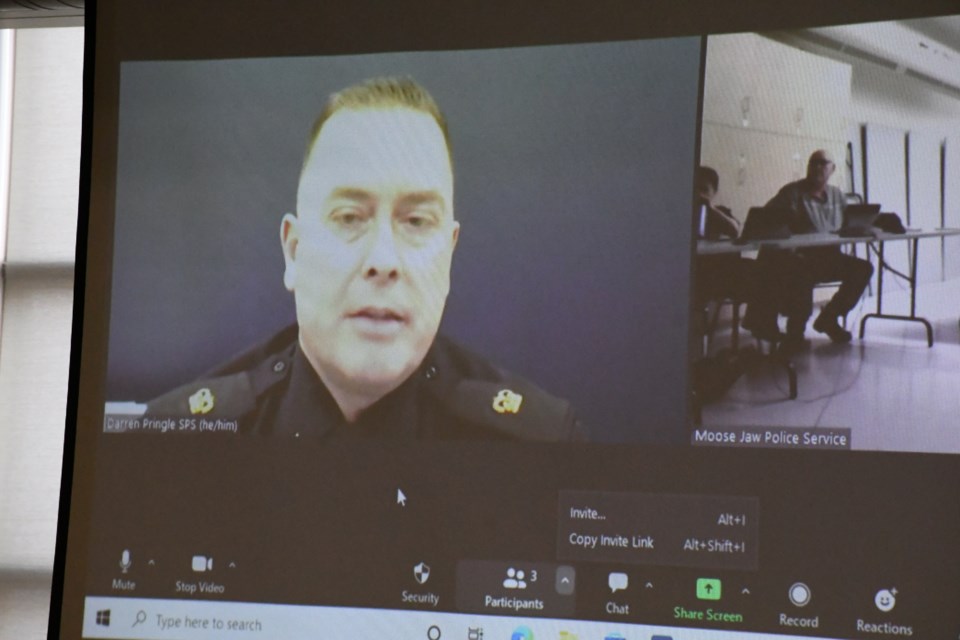The Saskatoon Police Service has developed a special policing initiative to improve community safety that does not involve fully armed officers — something the Moose Jaw Police Service is keenly watching.
Insp. Darren Pringle with the Saskatoon Police Service (SPS) spoke by Zoom to the Moose Jaw Board of Police Commissioners recently about the SPS’s Alternative Response Officers (AROs) program.
AROs, sworn in as special constables under the provincial community safety officer framework, are tasked with delivering public safety programs and community engagement during instances where the presence of armed officers is not required.
The SPS police board wanted an alternative service delivery program, so it provided the agency $350,000 and said, “Develop something,” Pringle explained.
“I’ve been around long enough that I’ve seen lots of programs get developed on anecdote, and I didn’t necessarily want this program to go in that direction,” he said.
“For it to be sustainable and last and encompass best practice, ensuring that we had some academic research as well as community consultation was key.”
SPS conducted research during the year-long pilot project — from July 2021 to June 2022 — because it wanted hard data that this would work.
This research included reviewing hundreds of peer-reviewed journal articles, analyzing gaps in service, and interviewing downtown businesses, residents and vulnerable people.
SPS found that data from the United Kingdom and Vancouver’s Downtown East Side proved that ARO-type members are effective in handling situations that didn’t require armed police, said Pringle.
Some service gaps the SPS identified included the need for a collaborative partnerships with community service providers and dedicated, visible beat officers.
“We really lacked that deep presence that people said … would provide a reassurance for them moving downtown,” Pringle remarked.
The SPS ran the pilot project in the downtown area and Riverside Business Improvement District since the organization believed if it succeeded there, it could work everywhere. It also found that AROs cost the SPS 85 per cent of what regular officers make, which showed they can cost-effectively address community concerns.
Another benefit is AROs freed up carbine-carrying patrol cars to handle more serious situations while the AROs — who don’t carry firearms — could deal with businesses experiencing graffiti or execute non-violent arrest warrants.
“It was making increasingly less sense for us to send a doomsday-equipped police car with a trained member … when we could have a special constable going to it … ,” the inspector said.
Data from July 2021 to June 2022 showed that AROs handled 1,897 calls for service, made 1,251 business contacts, issued 1,249 bylaw or provincial statute warnings, issued 581 tickets, and transported 631 people to jail or court.
Furthermore, they made 80 arrests for intoxication, laid 66 charges for crimes or drugs, issued 168 arrest warrants, guarded 29 crime scenes, participated in or led 46 parades or cultural ceremonies and saved 12 lives using NARCAN.
While the SPS wants regular officers with a Grade 12 education or GED, it wants ARO candidates to have degrees in social work, human justice, human studies or human services, Pringle said. Many people who want to help others don’t want to be a police officer, so this is another way for them to contribute.
“It’s enforcement when necessary, but not necessarily enforcement,” he added.
ARO training sees candidates spend 200 hours learning in the classroom, three extra weeks on provincial-specific legal issues, two extra weeks on Saskatoon-specific material, and must pass exams focused on seven specific areas.
Afterward, AROs spend 240 hours on field training, four extra weeks shadowing experienced beat cops and two extra weeks with a senior ARO.
Once they graduate, they work either Monday to Thursday to Tuesday to Friday from 8 a.m. to 6 p.m. Pringle noted that those timeframes are when business owners want to see uniformed officers.
“At the end of the pilot, we deemed it (the ARO program) a success … ,” he added, “and the board decided to bring it on board (permanently).”




